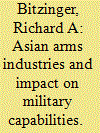|
|
|
Sort Order |
|
|
|
Items / Page
|
|
|
|
|
|
|
| Srl | Item |
| 1 |
ID:
153714


|
|
|
|
|
| Summary/Abstract |
Asia is a leading consumer of arms, and some of the most modern and most advanced armaments are finding their way into the inventories of Asian militaries. As a result, many Asian-Pacific militaries have experienced a significant, if not unprecedented, build-up over past several years, both in terms of quantity and quality. In addition to this trend, however, Asia has become an increasingly significant producer of armaments. Many nations in the region, if they can, have sought to supplant, or at least supplement, foreign arms suppliers with indigenous producers of needed weapons systems. However, for most Asian-Pacific militaries (the possible exception being China) indigenously produced weapons add only partial value to military capabilities. Consequently, imports of advanced weaponry remain a critical dependency for most of Asian-Pacific nations.
|
|
|
|
|
|
|
|
|
|
|
|
|
|
|
|
| 2 |
ID:
118178


|
|
|
|
|
| Publication |
2012.
|
| Summary/Abstract |
Can monetary policy, and the exchange rate, affect military capability? If weapons systems are purchased on international markets, then a depreciating currency can reduce the import of arms, affecting the relative capabilities of military rivals. In this research note, we analyze the demand for arms imports using an error correction model. We show that arms are a "normal" good, with the quantity demanded directly related to price and with exchange rates serving as an instrument for price movements that are normally unobserved. Such price movements are increasingly important given currency volatility and a reliance on imported technology.
|
|
|
|
|
|
|
|
|
|
|
|
|
|
|
|
| 3 |
ID:
186198


|
|
|
|
|
| Summary/Abstract |
The European Defence Technological and Industrial Base (EDTIB) is considered as a key element in the quest for a European Security and Defence Union. The EDTIB strategy initiated in 2007 aimed to lead to greater integration of the fragmented national defence industries of EU member-states, achieve economies through the coordination of defence industrial policy, the pooling of resources in the production and acquisition of weapons systems and better serve the political objectives of European defence. The paper examines the extent to which EU27 member-states satisfy their demand for arms through the procurement of EDTIB origin defence inputs. Moreover, it explores whether a process of convergence is present in terms of the share of EDTIB origin imports in the total arms imports of the EU member-states. The presence or not of a convergence process is examined empirically using β- and club convergence methodologies. In broad terms, the findings point to a process of convergence albeit at different speeds, as indicated by the club-convergence analysis.
|
|
|
|
|
|
|
|
|
|
|
|
|
|
|
|
| 4 |
ID:
116070


|
|
|
|
|
| Publication |
2012.
|
| Summary/Abstract |
With the burgeoning influence of emerging markets in Asia, a tectonic shift is taking place in the global security landscape. Asian states are concomitantly arming as their economic clout grows. In light of these developments, security analysts would benefit from a formal means of placing these arms acquisitions in a structural context. Are arms acquisitions on par with the expectations of Asian states, given their structural dispositions, or are recent acquisitions beyond anticipated levels? By using a dynamic panel regression of 187 states from 1950 to 2011, this research predicts arms import volume using the degree of interstate arms linkages, the size of a state's military, and its level of economic development. The technique offers analysts a formal means of distinguishing orthodox behavior in importing conventional weapons from extraneous security motivations. The article concludes by generating near-term forecasts of Asian arms imports and discussing the implications of the technique.
|
|
|
|
|
|
|
|
|
|
|
|
|
|
|
|
| 5 |
ID:
184054


|
|
|
|
|
| Summary/Abstract |
This study examines whether governments use the revenues accruing from agricultural taxes to finance their arms imports. This policy issue is especially of importance for developing countries as the decision to finance the acquisition of arms using agricultural taxes will create a trade-off between two important policy objectives in these countries: on the one hand, ensuring food security for the population at large and, on the other hand, improving national security. Our empirical findings generally suggest that governments in developing countries partly finance their arms imports by increasing the agricultural tax rate. It turns out that the magnitude of this effect relies to a certain extent on country-specific factors such as whether a country has to deal with a security threat, strength of the democratic institutions in place, and the regular occurrence of major shocks to the domestic food provision. Also, taxes on cash crops intended for export are more likely to be used for financing the arms imports compared to taxes on import-competing or subsistence crops.
|
|
|
|
|
|
|
|
|
|
|
|
|
|
|
|
|
|
|
|
|